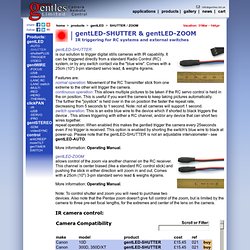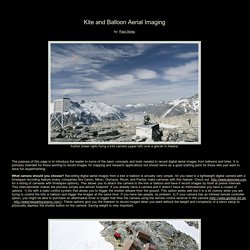

PRISM IR Camera Control for Canon WL-D88. Gentles Limited: gentLED-SHUTTER & ZOOM. GentLED-SHUTTER is small, lightweight and easy to use with a RC control system. gentLED-SHUTTER is our solution to trigger digital stills cameras with IR capability.

It can be triggered directly from a standard Radio Control (RC) system, or by any switch contact via the "blue wire". Comes with a 25cm (10") 3-pin standard servo lead, & weighs 4grams. Features are:normal operation: Movement of the RC Transmitter stick from one extreme to the other will trigger the camera. continuous operation: This allows multiple pictures to be taken if the RC servo control is held in the on position. This is useful if you want the camera to keep taking pictures automatically.
More information: Operating Manual. gentLED-ZOOM is small, lightweight and easy to use with a RC system. gentLED-ZOOM allows control of the zoom via another channel on the RC receiver. More information: Operating Manual. Note: To control shutter and zoom you will need to purchase two devices. IR camera control: Angle of view. A camera's angle of view can be measured horizontally, vertically, or diagonally.

In photography, angle of view describes the angular extent of a given scene that is imaged by a camera. It is used interchangeably with the more general term field of view. It is important to distinguish the angle of view from the angle of coverage, which describes the angle range that a lens can image. Typically the image circle produced by a lens is large enough to cover the film or sensor completely, possibly including some vignetting toward the edge. If the angle of coverage of the lens does not fill the sensor, the image circle will be visible, typically with strong vignetting toward the edge, and the effective angle of view will be limited to the angle of coverage. Calculating a camera's angle of view[edit] For lenses projecting rectilinear (non-spatially-distorted) images of distant objects, the effective focal length and the image format dimensions completely define the angle of view.
Radians or Now. Digital aerial images from kites or balloons. How do I get the camera airborne?

Now that you have your camera ready, you need a way to get it up in the air. There are 4 options I’m going to chat about: hot air balloons, hydrogen balloons, helium balloons and kites. Hot Air Balloons: There are two types of hot air balloons: solar heated and combustion heated. The solar balloons rely on the solar radiation from the sun to heat the air inside the balloon. Believe it or not, they actually work; in fact they can be big enough to lift people ( You need a pretty calm day and bright sun but if you have these conditions it’s a pretty neat trick to get a camera in the air without any additional fuel source.
Hydrogen balloons: (don’t even go down this road). Helium Balloons: Now this is the way to go. Kites: These work great when you have steady wind.